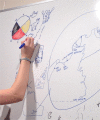Whiteboard animation for knowledge mobilization: a test case from the Slave River and Delta, Canada
- PMID: 26507716
- PMCID: PMC4623287
- DOI: 10.3402/ijch.v74.28780
Whiteboard animation for knowledge mobilization: a test case from the Slave River and Delta, Canada
Abstract
Objective: To present the co-creation of a whiteboard animation video, an enhanced e-storytelling technique for relaying traditional knowledge interview results as narratives.
Design: We present a design for translating interview results into a script and accompanying series of figures, followed by technical steps to create a whiteboard animation product.
Method: Our project used content analysis and researcher triangulation, followed by a collaborative process to develop an animated video to disseminate research findings. A 13-minute long whiteboard animation video was produced from a research study about changing environments in northern Canadian communities and was distributed to local people. Three challenging issues in the video creation process including communication issues, technical difficulties and contextual debate were resolved among the supporting agencies and researchers.
Conclusions: Dissemination of findings is a crucial step in the research process. Whiteboard animation video products may be a viable and culturally-appropriate form of relaying research results back to Indigenous communities in a storytelling format.
Keywords: Indigenous studies; e-storytelling; knowledge mobilization; traditional knowledge; whiteboard animation.
References
-
- Battiste M. Indigenous knowledge and pedagogy in First Nations education: a literature review with recommendations. Ottawa: Apamuwek Institute; 2002.
-
- Piquemal N. From Native North American oral traditions to Western literacy: storytelling in education. Alberta J Educ Res. 2003;49:113–22.
-
- Dowell K. Indigenous media gone global: strengthening Indigenous identity on-and offscreen at the First Nations/First features film showcase. Am Anthropol. 2006;108:376–84.
-
- McCall S. First person plural: Aboriginal storytelling and the ethics of collaborative authorship. Vancouver: UBC Press; 2011.
-
- McKeough A, Bird S, Tourigny E, Romaine A, Graham S, Ottmann J, et al. Storytelling as a foundation to literacy development for Aboriginal children: Culturally and developmentally appropriate practices. Can Psychol. 2008;49:148.
Publication types
MeSH terms
LinkOut - more resources
Full Text Sources
Other Literature Sources

